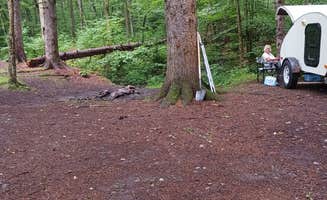Dispersed camping near Derby, New York encompasses several primitive areas across state-managed forestlands. These sites follow New York's standard dispersed camping regulations, which typically permit camping at least 150 feet from water sources, trails, and roads. Most locations experience four distinct seasons with summer temperatures averaging 70-85°F and winter temperatures frequently dropping below freezing, making seasonal preparation essential for campers venturing into these undeveloped areas.
What to do
Hiking the Finger Lakes Trail: At Boyce State Forest, campers can access portions of the 580-mile Finger Lakes Trail system. "If roughing it is your thing this is primitive tent sites on a small pond located on the Finger Lake Trail. If you walk/hike 1/2 mile you will find a lean-to with fire pit and privy," notes visitor Alan C.
Creek exploration: Camp Seneca offers creek-side sites perfect for water exploration during warmer months. According to Kevin C., "We came into the area on a Monday and this camp was completely empty. We picked the biggest site next to the creek." The small waterways in the area are typically shallow enough for wading but can rise during rainy periods.
Wildlife observation: The forests surrounding Derby provide habitat for white-tailed deer, wild turkey, and numerous bird species. Morning and evening hours offer the best wildlife viewing opportunities, with minimal light pollution at most sites enhancing stargazing conditions after sunset.
What campers like
Seclusion and privacy: Most dispersed camping areas near Derby remain relatively uncrowded even during peak summer weekends. Kevin C. appreciates Camp Seneca's isolation: "This campground had several designated sites and most have a fire ring and picnic table. We had a few hikers come through and one other camper that chose not to stay."
Natural shelter: The dense forest canopy at many sites provides natural protection from elements. "The tree canopy over our site was dense enough that we did not get very wet when it rains," reports a Camp Seneca visitor, highlighting an advantage during brief summer showers.
Free camping options: Warner Road Dispersed Camping in North Harmony State Forest provides no-cost options for budget-conscious travelers. Rose S. explains its utility: "It served its purpose as a free place to sleep along a longer trip." These areas typically require self-sufficiency but offer substantial cost savings compared to developed campgrounds.
What you should know
Cleanliness concerns: Some dispersed sites suffer from maintenance issues. A Warner Road visitor reported: "Kind of a gross site, the previous people who stayed at our site were messy and left litter." Bringing trash bags and practicing leave-no-trace principles helps mitigate these conditions.
Confusing signage: Verify overnight camping permissions before setting up. Denise D. cautions about Warner Road: "Clearly people are camping here at times but there are posted signs that say Day Use Only. It was quiet and dark." Contact the regional DEC office before trips to confirm current regulations.
Seasonal trail conditions: Weather significantly impacts accessibility at McCarthy Hills Forest and similar areas. According to Boyce State Forest visitor Zack B., "Would recommend to come in dryer season or to bring rubber boots." Spring thaws typically create the muddiest conditions, while late summer and early fall offer drier ground.
Tips for camping with families
Bathroom planning: Limited sanitary facilities require advance preparation for family camping. One Camp Seneca visitor noted, "There was a porti-poty on site that had plenty of paper was pretty clean." At sites without facilities, pack a portable toilet system and sanitization supplies.
Site selection for children: Choose areas with level terrain and natural boundaries. The creek-side sites at Camp Seneca provide natural play areas while keeping children within visual range of the campsite.
Emergency preparation: Cell service remains inconsistent throughout the dispersed camping areas near Derby. Windfall Ponds and similar remote locations require extra precautions, including detailed trip plans left with non-traveling contacts and basic first aid supplies.
Tips from RVers
Access limitations: Most dispersed areas have restricted vehicle access. While Warner Road accommodates larger vehicles, other sites require high-clearance vehicles or hiking gear to reach camping areas.
Leveling challenges: Bring substantial leveling blocks as most sites feature uneven terrain. RVs under 25 feet generally navigate forest roads more successfully than larger units, particularly after weather events.
Waste management: With no dump stations available at dispersed sites, RVers must plan for complete waste self-containment. The nearest dump facilities are typically at state parks or private campgrounds around 20-30 miles from most dispersed sites.


